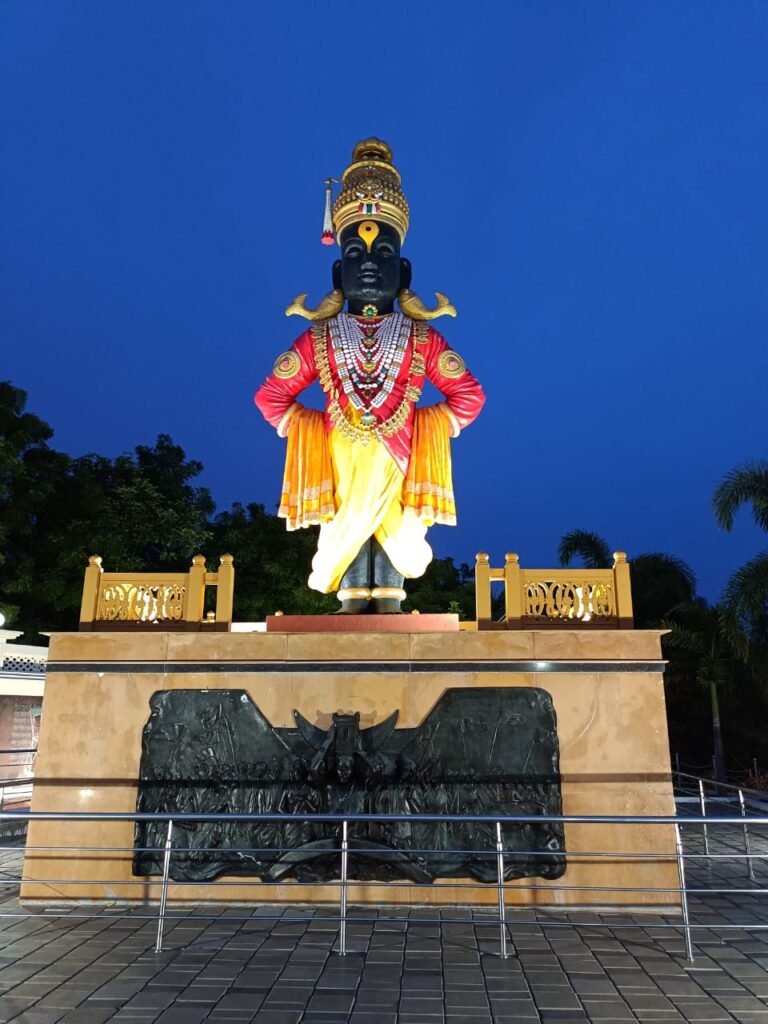Chandrabhaga River, one of the major rivers of Western India, takes the shape of a crescent moon as it encircles the small and beautiful village of Pandharpur. The holy town is the abode of Lord Vitthala, a Hindu God widely believed to be an incarnation of Lord Krishna.
Krishna, himself an incarnation of Lord Vishnu, one of the three Gods that form supreme divinity, is worshipped and deeply loved in northern India. He is widely revered as a child who could summon the image of the entire universe in his mouth, as a youth who defeated his evil maternal uncle to free his hometown from oppression and misery, as a gentle shepherd, the focus of love and devotion of all gopis (young town girls), as the savior of Gokul from many rakshasas and disasters, as a friend and guide to the exemplary warrior Arjuna, as a protector, as the source and speaker of the world’s most widely read book over the centuries, the Bhagavad Gita. Vrindavan, the place where Lord Krishna is believed to have grown up, is today filled with devotees from across the world. But in Pandharpur, Krishna, in the form of Lord Vitthal, is more than any of his feats and achievements; He is the embodiment of love.
Mathura in Uttar Pradesh may have been the birthplace of Krishna, and now submerged, the city of Dwarka in Gujarat may have been his home in the latter part of his life, but Pandharpur in Maharashtra is where he resides even today, as his devotees across Maharashtra, Madhya Pradesh, and Karnataka believe.
Because our country has lived through numerous civilizations, invasions, communities, and kingdoms, India, as we know it today, has become a melting pot of not only several languages, clothes, and cultures but also several narratives about one story and one God. For the same reason, Pandharpur itself is divided about the identity and the origin of Lord Vitthal. While most would recount the story of him being an incarnation of Krishna, many still believe that Lord Vitthala is a God in himself, independent of Krishna, and actually, a God incarnated in the form of a peasant boy born into a poor family. This is why many across the states of Maharashtra and Karnataka hail him as the God of the poor. This is also why farmers across these states relate better with Lord Vitthala and love Him with all their hearts.
There are definitely many overlaps in both versions of Lord Vitthala’s origin and story. For example, both were cowherds. But Krishna was neither born to poor parents nor raised in a poor family. Another similarity is the name of their wives – Queen Rukmini. But the reason why Lord Vitthala becomes the embodiment of pure love that exists between a God and his devotee is one and the same story in both narratives.
Lord Vitthala’s Walk for his Devotee
There was once a man named Pundalik. Much like many youths today, he did not care for his parents, and growing up, he treated them worse than strangers. Once, Pundalik decided to accompany his parents with his wife to visit the Kashi Vishwanath temple. En route, they found themselves in need of rest, and Saint Kakudi, whose hut lay nearby, offered them a place to stay. Talking to the Saint, Pundalik candidly asked him if he had ever visited the great Kashi temple. When Saint Kakudi replied in the negative, the disappointed Pundalik doubted Kakudi’s legitimacy as a Saint and asked him how he could call himself a saint if he had never visited the great pilgrimage site, which is supposed to be the gateway of connecting man to God. Saint Kakudi calmly replied that God is everywhere, especially for their devotees, and that no man needs to visit any pilgrimage site for their darshan if their devotion is true. Still disappointed and now convinced that the Saint was a fake, Pundalik went to sleep.
When, at night, Pundalik woke up thirsty, he happened to peep into the Saint’s chamber, wherein he saw two angel-like ladies emanating a bright aura, serving water to the Saint while he sat in his meditation spot. Shaken and scared to interfere, Pundalik went back to sleep. In the morning, he immediately went to the saint to recount what he had seen the last night to confirm if it was true or just a dream. Saint Kakudi, reassuring him that he was not dreaming, told him that the angelic figures were Goddess Ganga and Saraswati. He was meditating in their name and hence they were there, answering his prayers. Bewildered, Pundalik asked how the Saint could gain visits from Goddesses when he had never undertaken the pilgrimage. The Saint replied that all the God needs from their devotees is selfless karma and devotion – to one’s responsibilities, humanity, and God himself.
The incident transformed Pundalik’s perception. Turning into a dedicated son, he became ever so involved in serving his parents. It was when he was taking his parents to the pilgrimage of Krishna Janmabhoomi, that Lord Krishna, impressed, is believed to have started walking towards Pundalik. (Or in another version, he prays to Lord Vitthala day and night and Vitthala decides to pay him a visit himself.) Pundalik was in Pandharpur when Lord Krishna, walking all the way with his cattle, reached the village.
When Krishna reached Pundalik’s door, the latter was in the midst of taking care of his parents. Prioritizing his duty, Pundalik threw an eet (brick) towards Lord Krishna and asked him to stand on the eet till he had finished his duties for the day. Immensely impressed by Pundalik’s devotion to his karma, Krishna stood there waiting for him, and when Pundalik finally approached to take his blessings, Krishna decided to give him a boon and asked Pundalik to name any wish that he may have. Now a selfless devotee, Pundalik requested the Lord to forever stay in the exact same place, so that all his devotees in the region might not have to undertake a difficult and faraway pilgrimage for his darshan.
Complying, Krishna is believed to have stayed there, on that very eet, in his ‘Panduranga’ form forever. One of the pandits from the village shared that since Krishna walked from Dwarka to Pandharpur, his whole body was covered in soil, turning him black, and hence getting named Panduranga, for Pandu means the color of soil in the regional language. His other names, Vitthhal and Vitthoba, come from the fact that the Lord stands on the vitt (meaning brick in the regional language), and hence gives the Lord the name of ‘the one who stands on vitt for his devotees.’
Every year, during Ashadh Ekadashi (Ekadashi in the month of Ashadh according to the Hindu calendar), people in lakhs arrive in Pandharpur for darshan, to touch the feet of the Lord. The love and adoration for Lord Vitthala in the states of Maharashtra, Karnataka, and some parts of Gujarat and Madhya Pradesh is such that people on the pilgrimage regard him as Mauli, meaning mother, because they believe that Lord Vitthal’s love for his devotees is similar to that of a mother. In 2024, Ashadh Ekadashi saw 27 lakh people arrive in the small village of Pandharpur. These devotees stand in line for 4-5 days, a line that starts from the neighboring village, Gopalpur, ultimately leading the devotees to the Lord Vitthhala temple. People believe that the temple, first constructed by King Vishnuvardhana of the Hoysala Empire between 1108 and 1152 CE, stands at the exact same spot where Lord Krishna stood in his Vitthala form for Pundalik. The temple pujaris collect the dust of the corridor used by devotees to enter the temple to make tilak (a distinctive spot of colored powder or paste worn on the forehead). Over a large yellow tilak, the black tilak made from devotees’ dust is applied to Lord Vitthhala’s animated and magnetic sculpture.
A temple dedicated to the devotee who brought the God to the village, Pundalik, stands on the Chandrabhaga river shore. But the temple gets submerged every year during the monsoon season – the depth of submersion depends on the monsoon intensity at the time. If you keep walking along the shore, a separate, small temple dedicated to Lord Vitthala’s wife Rukmini stands strong, inspiring awe. Many local females visit the Rukmini temple daily for her blessings as Maa Rukmini is revered as the embodiment of prosperity and filial love. She has a separate story in the town in which she is believed to have run away from Dwarka to Pandharpur after getting irritated at Lord Krishna. And it is believed that when Krishna comes to apologize and bring her back home, is when he imprints his footprints at a place that is now worshiped as Vishnu Pad Mandir, which also lies on the shore of the Chandrabhaga River, although a little far from the main temple.
The beauty of Pandharpur lies as much in its treasure of mythical stories as in its beautiful energy of love, acceptance, and joy, in its hospitality, food, and a capable administration. For, even when the village receives constant footfall of devotees around the year and a humungous crowd twice a year, the dynamic town continues to preserve many cultures and traditions. It manages to host them all, feed them all, and love them all. Just like it loved me, and just like it made me fall in love with it.



